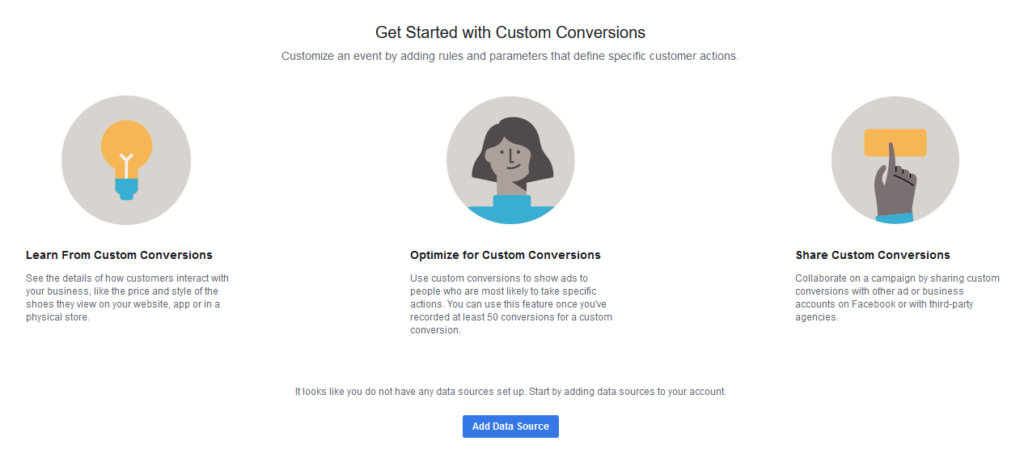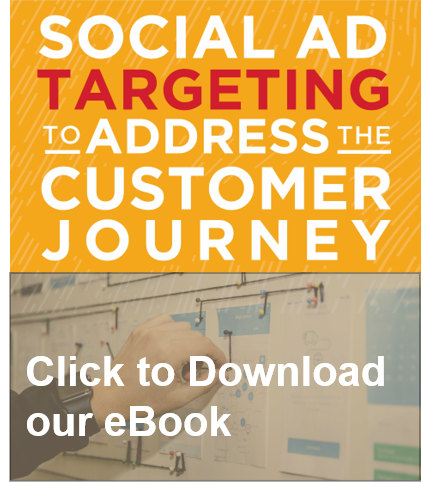
06 May Social Ad Targeting to Address the Customer Journey – Phase IV : Loyalty Targeting

- Phase I: Social Ad Targeting to Address the Customer Journey – Broad Targeting
- Phase II: Social Ad Targeting to Address the Customer Journey – Qualified Targeting
- Phase III: Social Ad Targeting to Address the Customer Journey – Lead Conversion
It’s a significant outlay of money to gain a new customer so it’s often more beneficial to keep the ones you already have. The loyalty phase of the customer journey keeps your best customers coming back for more. They may also refer your brand to friends and family; an extremely efficient way to add new customers into the funnel. Paid social media is one way to give attention to this most-deserving audience to maintain what has become an important business relationship. Here are some ways to use paid social to reach your loyal customers and impact your bottom line:
- Cross-sell products and/or services. Basically, sell more stuff. For instance, if a customer purchases an amazing set of earrings and there are more pieces to the set, you can market the remaining pieces such as the bracelet, ring, and necklace.
- Upsell products and/or services. Have an upgrade available or a version with more bells and whistles? This is a good opportunity to see if a satisfied customer is ready to step up their game!
- Reward them. Don’t let them forget how important they are to you. One way to do this is to reward them with special deals, gift cards, exclusive events, and/or other meaningful ways to show how important they are to your business.
- Collect positive reviews. A positive review of a product or service can help convert a shopper in the consideration phase. Asking your loyal customers to provide reviews or recommendations goes a long way, especially since many users count on them when making a purchase decision.
Building your audiences:
It’s important to employ a few pieces of technology into audience targeting during the loyalty phase. We’ve mentioned using the pixel data in many of our blog posts as it’s a critical piece to leverage when constructing your targeting strategy. For the best results, be sure events are tracked (note: avoid using automatic events). With the pixel in place and firing correctly, you can create custom loyalty audiences and market to them accordingly. Here are just a few examples.
- Audiences that spend certain currency ranges. If the average cart size is $50 and you have a customer that spent $20, there might be an opportunity to increase their overall spend by offering meaningful suggestions of other products or services. Conversely, if someone has purchased well above the average cart size, let’s say $250 in this example, this might be a good opportunity to reward them.
- Audiences that purchased specific products/services. What if you have learned from customer behavior that if someone purchased Y, they’d be inclined to purchase Z? Let’s say you sell outdoor furniture and if you sell a couch, you can almost always sell a fire bit in the same line. Here’s a great opportunity to cross-sell the fire pit to the couch audience.
- Audiences that haven’t purchased recently. Has it been a while since someone purchased from you? Maybe it’s time to remind them of your value prop or maybe you have a new line to sell. It could also be that it’s time for a replacement or refill. All good use cases to use paid to target based on your unique purchase cycle data.

In addition, or instead of a pixel, you may have email addresses and/or other pieces of contact data such as phone number to do a match. The data is always hashed (so it won’t give away any personal information, same goes for the pixel). If CRM data is available and to the extent it can be segmented, you can create audiences similar to the ones listed above … and then some.
The other audience that you shouldn’t ignore are those connected to your social pages. These are your social fans and followers. They took time to connect with you and may see your organic content through their feeds so be sure and pay some special attention to them. Rewards and exclusive offers or even unique experiences are just one way to express their importance to your brand and help solidify your relationship.
Using your audiences:
To get the most of audiences during the loyalty phase, use objectives such as reach and website conversion. Steer away from awareness, unless you are introducing a new product or services. Focusing on engagement may limit your reach, so stick with reach to get to the most loyal customers you can from your finite set.
Like re-targeting audiences, loyalty audiences require some special care. Here’s a few best practices to keep top-of-mind when using paid social to target to this unique group:
- Pay attention to your frequency. This is likely not an awareness play be sure you have a frequency that leads to the desired behavior but doesn’t hit a point of diminishing returns.
- Apply the right content approach. Do not blanket a general message to this group. Each audience likely supports a specific purpose so make sure that you are thinking through your marketing communications strategy and asking for the right call-to-action.
- Keep your data well-organized. These audiences are dynamic. Be sure that you are updating your data and creating a naming system that keeps the data current and makes swapping out audiences a breeze. It will take you some time up front to plan it out but will save more time than that (plus some) in the end.
- Watch your budgets. These audiences might be relatively small in some cases so don’t feel like it requires the same lofty dollars that might be needed for campaigns in other phases of the journey.
- Turn on conversion lift studies: Are you wanting to know how well your efforts paid off? It’s getting much easier to run conversion lift studies to show how exposure to your content impacted marketing events from your audience when compared to a control group.
You are up-to-speed on the benefits and ways to use paid social audience targeting during the loyalty phase of the customer journey.

Curious how we can put our content creation methodology to work for your brand? Let’s get the conversation started.







